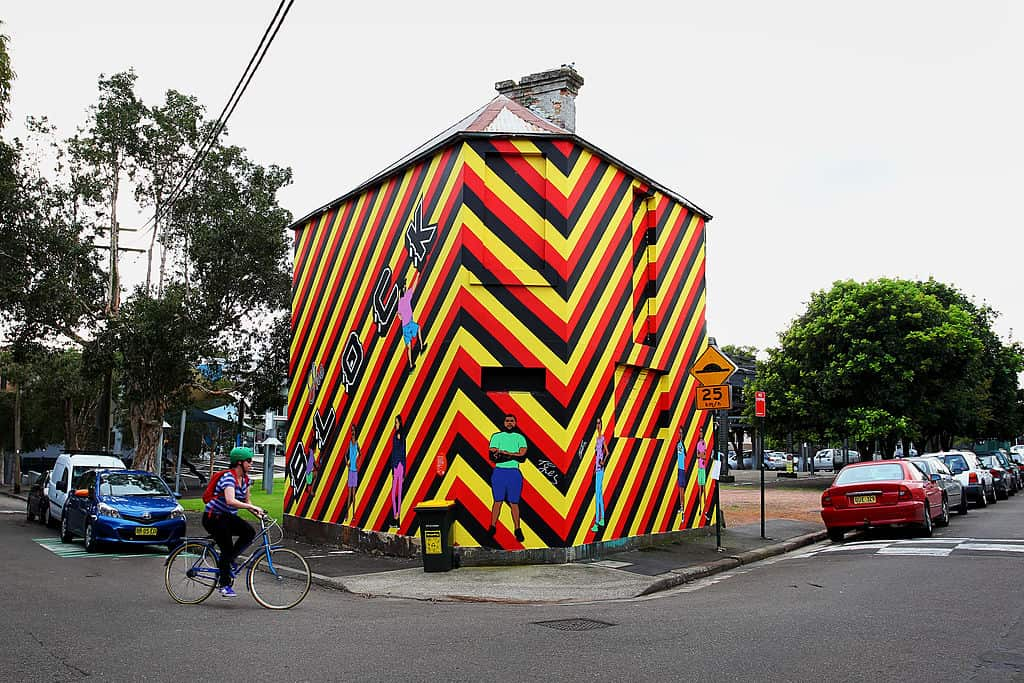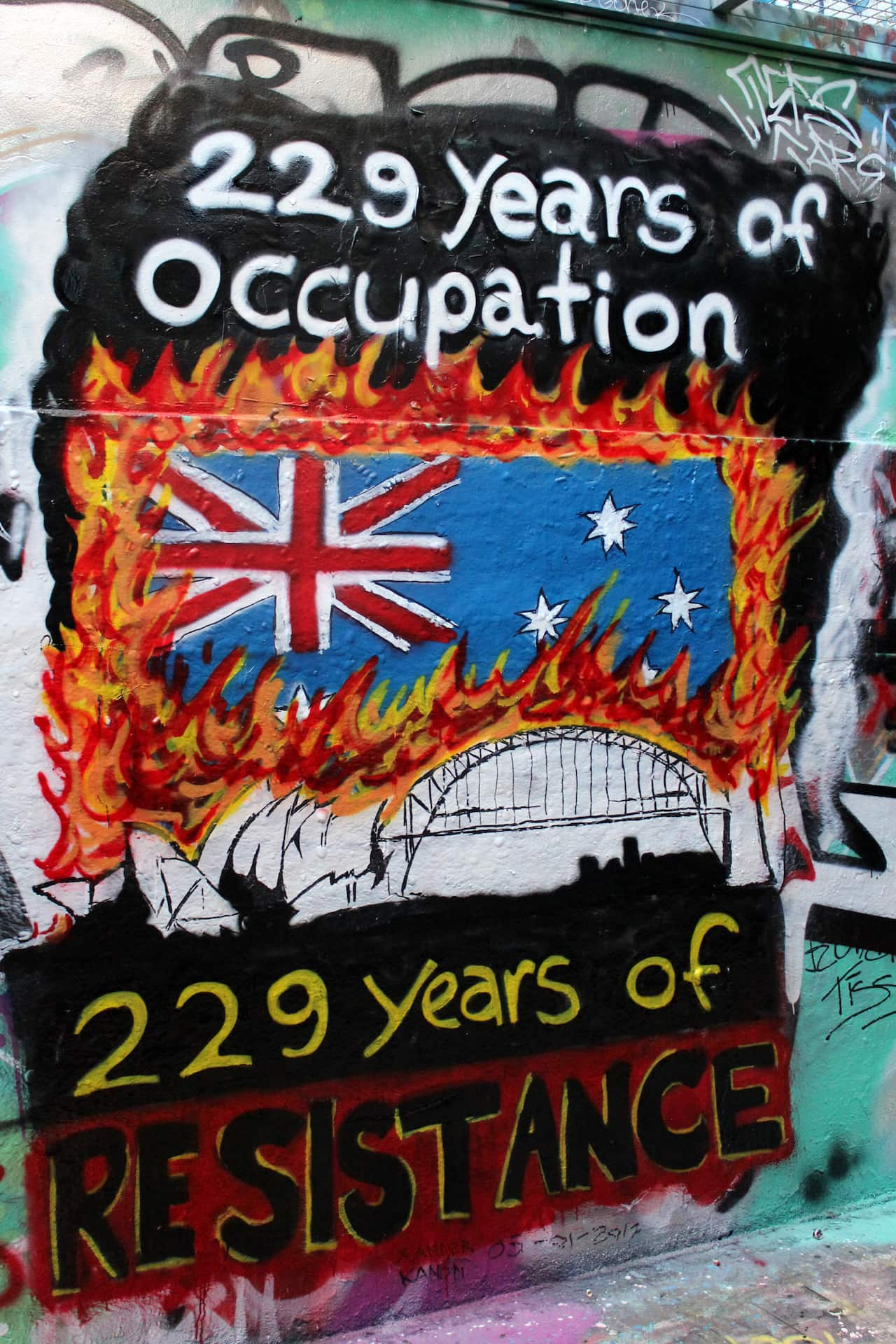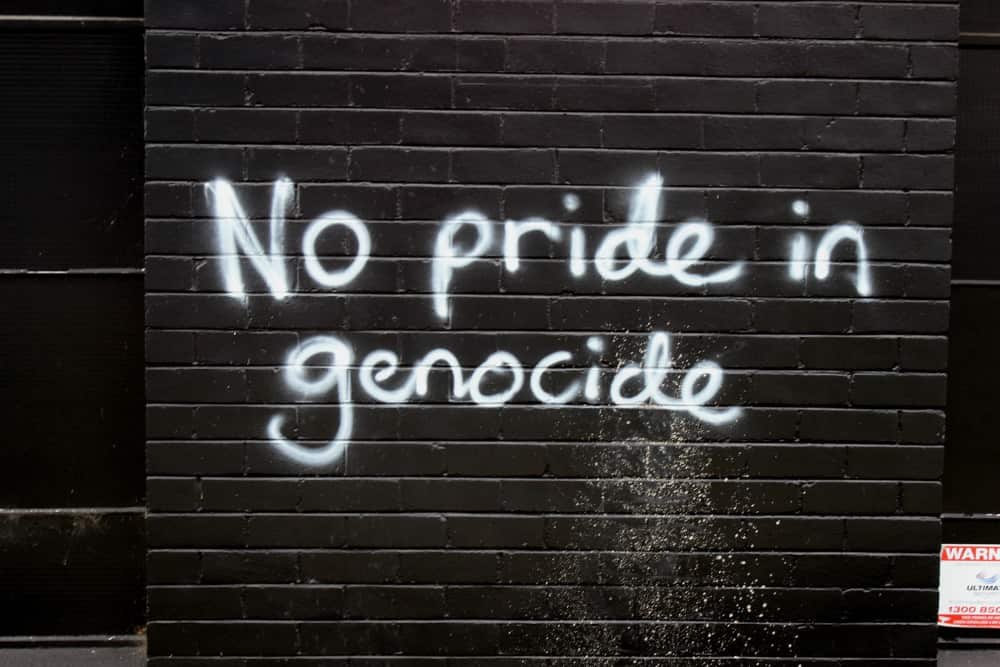A Victorian terrace on the corner of Redfern’s infamous, , is transformed into red, yellow and black, portraits of an elder and the artists, with the words ‘Welcome to REDFERN’ stamped across the exposed brick wall. Currently an empty site awaiting development, The Block was purchased by the in the 1970s to house the local Indigenous community who occupied the precinct. What was once a kind of refuge community for Indigenous Australians, The Block has gradually become a historic landmark nestled within hospitality hotspots and advertising agencies. 
 While Redfern is now heavily gentrified, the street art that covers numerous walls, including the Lawson St bridge opposite Redfern station, are vital parts of the suburb's cultural heritage and highlights a powerful message of survival and resilience.
While Redfern is now heavily gentrified, the street art that covers numerous walls, including the Lawson St bridge opposite Redfern station, are vital parts of the suburb's cultural heritage and highlights a powerful message of survival and resilience.

Reko Rennie's 'Welcome to Redfern' painted on a building in Sydney's inner-city Source: Bloomberg

Reko Rennie's artwork on Redfern's 'The Block' in Sydney's inner-city Source: Bloomberg
Kamilaroi man and established artist, created Welcome to Redfern (2013) in collaboration with young artists from the Redfern community as a project part of the ; a Sydney city visionary project celebrating Indigenous culture. Emblazing the colours of the Aboriginal flag on a dilapidating terrace, Welcome to Redfern is a strong symbol and reminder of the history, activism, community and culture of Redfern, and Rennie's signature colour-block design upon the urban canvas is an exploration of what defines Aboriginal and Torres Strait Islander art.
Indigenous street art has been and continues to be a powerful tool to reclaim, intervene and decolonise urban spaces. Compelling words and images painted over colonised spaces exist as a strong and unapologetic reminder that Australia always was and always will be Aboriginal and Torres Strait Islander land, which is communicated to the general public. Public Indigenous art is often personal and political, challenging the viewer and forcing its onlookers to ask questions and start conversations. Defying the usual grounds of the white walled galleries of major art institutions, the streets offer an inclusive and accessible space for the public to freely engage with contemporary Indigenous art and promote discussion about past and current Indigenous issues. For example, the recent addition to Melbourne's Fitzroy by Gunnai/Wiradjuri man, acknowledges to the suburb's past and continuing Indigenous history and stories. Fitzroy is renowned for its influence in Australia's cultural landscape, however the Aboriginal history of this area is very rarely discussed, something Young's collaborative piece aims to change. The collaborative piece with other artists, Heesko and Makatron is more than just a public artwork. The mural, like other Aboriginal and Torres Strait Islander public art, presents an opportunity for the community to question and reflect on the country's narrative. Incorporating stories of Bunjil the eagle, the creator of the Kulin nation (Melbourne), shares contemporary stories while illustrating the history of this specific site. Now located outside trendy restaurant and social enterprise, the building was originally a bank before becoming an long-serving Aboriginal community health centre. The significance of the Charcoal Lane and its community eventually became the title of Archie Roach's 1990 album, 'Charcoal Lane'.
For example, the recent addition to Melbourne's Fitzroy by Gunnai/Wiradjuri man, acknowledges to the suburb's past and continuing Indigenous history and stories. Fitzroy is renowned for its influence in Australia's cultural landscape, however the Aboriginal history of this area is very rarely discussed, something Young's collaborative piece aims to change. The collaborative piece with other artists, Heesko and Makatron is more than just a public artwork. The mural, like other Aboriginal and Torres Strait Islander public art, presents an opportunity for the community to question and reflect on the country's narrative. Incorporating stories of Bunjil the eagle, the creator of the Kulin nation (Melbourne), shares contemporary stories while illustrating the history of this specific site. Now located outside trendy restaurant and social enterprise, the building was originally a bank before becoming an long-serving Aboriginal community health centre. The significance of the Charcoal Lane and its community eventually became the title of Archie Roach's 1990 album, 'Charcoal Lane'.

Anti-colonial graffiti painted around sydney in the lead up to 26 January 2017 Source: Insurrection News
Char
Indigenous street art can also extend beyond preconceived ideas of 'what is' art. The art of tagging, for example, is often more understood than other forms of graffiti. By occupying a public space and asserting the power and expression, it disrupts an urban space in multiple ways without permission – interrupting the planned nature of a city. The statement ‘No pride in genocide’ or '' speaks directly to the struggle, resistance and survival of our people through the disruption of an untouched urban wall. Tagging with an Indigenous hand in an Indigenous voice will always tell a story of culture, identity, politics and self expression and consequently be an artform in a way that marking 'was here' followed by a year, never can.  Outside of gallery space, the street doesn’t discriminate, offering a very bold and public expression that is readily available to everyone. It's an exhibition of the vast diversities of Indigenous people and culture, as well as challenging the definitions of what Indigenous art should look like and where it is headed.
Outside of gallery space, the street doesn’t discriminate, offering a very bold and public expression that is readily available to everyone. It's an exhibition of the vast diversities of Indigenous people and culture, as well as challenging the definitions of what Indigenous art should look like and where it is headed.

Anti-colonial graffiti painted around Sydney in the lead up to 26 January 2017 Source: Insurrection News
Whether it be a small tag, an engraving of the Aboriginal flag in wet concrete, or a large scale mural cascading down the side of a city building, it will always be a reminder to the viewer that they are on Aboriginal and Torres Strait Islander land, that sovereignty was never ceded, and we always have and will continue to fight.
Georgia Mokak is Djugun and a member of Yawuru. She writes about art, education and identity.
Colour Theory Underground documents the lives for four Indigenous street artists. airs Tuesdays at 8.00pm on NITV Ch. 34 or catch-up .





